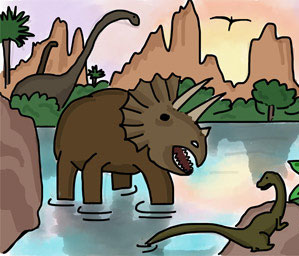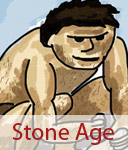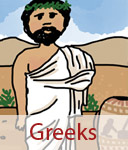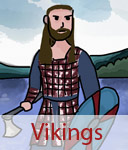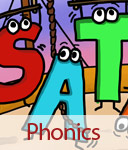Dinosaur games online
Dinosaur games online and dinosaur facts for kids learning at Foundation Stage at Primary School. Homework help on the history of the Dinosaurs.
Time: 230 million - 65 million years ago
What were the dinosaurs?
About 225 million years ago, dinosaurs evolved from early reptiles. But they were not quite the same as the reptiles we know today, like lizards or snakes. Dinosaurs stood upright, with legs positioned directly under their bodies instead of sticking out to the sides — this made them stronger, faster, and able to grow much larger than any animal before them.
Some dinosaurs had four powerful legs for walking, like the giant Brachiosaurus, while others balanced on two long back legs, using shorter front limbs like arms — perfect for grabbing food or fighting! They were the most successful animals on Earth, ruling the land for over 165 million years.
Dinosaurs came in all shapes and sizes. Some were small enough to fit under your desk, like Microraptor, while others, like Argentinosaurus, were longer than three double-decker buses! Some could sprint faster than a racehorse, others moved slowly, using their size to scare away hungry predators.
They were truly the kings and queens of the prehistoric world — and they dominated it for far longer than humans have ever existed!
Dinosaur games
 Andy's Dinosaur Adventures Game
Andy's Dinosaur Adventures Game Join Andy to find dinosaurs, play fun games and collect all the badges.
 Dinosaur Train Games
Dinosaur Train GamesJoin the Dinosaur Train and learn about Dinosaurs and play games like Fossil Finder, Dino Drink & River Run.
 Dino Dig
Dino Dig Hey, dinosaur hunter! Travel the world to dig up cool dinosaur fossils!
When did the dinosaurs live?
Dinosaurs ruled the Earth for an incredibly long time — over 165 million years! They lived during a period of Earth’s history called the Mesozoic Era, often called “The Age of Dinosaurs.”
The Mesozoic Era was split into three main time periods:
- Triassic Period (about 250–200 million years ago)
This was when the first dinosaurs appeared. They were small, light, and fast, like Coelophysis, which hunted tiny animals and insects. The world looked very different then — all the continents were joined together in one giant supercontinent called Pangaea, and the climate was hot and dry. - Jurassic Period (200–145 million years ago)
This was the time of the giants! Huge plant-eaters like Brachiosaurus and Diplodocus walked the Earth, while predators like Allosaurus hunted them. The world was becoming greener, with lush forests and plenty of food for dinosaurs to eat. - Cretaceous Period (145–66 million years ago)
This was the final chapter of the dinosaur age. Dinosaurs like Tyrannosaurus rex, Triceratops, and Velociraptor ruled the land. Flowers began to grow for the first time, and insects like bees appeared. But at the very end of this period, something dramatic happened — the dinosaurs suddenly disappeared from the Earth forever.
Meat-eaters and plant-eaters
Dinosaurs came in two main types, depending on what they ate: carnivores and herbivores.
Carnivories
Carnivores were meat eaters. They hunted other dinosaurs or scavenged animals that were already dead. Carnivores had sharp teeth and claws to help them tear through flesh. One of the most famous was Tyrannosaurus rex, which had teeth as big as bananas and could crush bones with one bite! Another fierce hunter was the Velociraptor, which was smaller but fast and clever, using its claws to grab prey.
Herbivores
Herbivores were plant eaters. They spent their days munching on leaves, ferns, and fruit. Some, like the Diplodocus, had very long necks to reach tall trees. Others, such as Triceratops, had strong beaks for chewing tough plants. Because herbivores didn’t hunt, they had to defend themselves from carnivores. Some had horns, spikes, or armour plates to stay safe. The Ankylosaurus, for example, had a tail like a giant club that it could swing to knock down attackers.
Life was a constant battle between hunters and the hunted — one trying to eat, the other trying not to be eaten!
How big were the dinosaurs?
Dinosaurs came in an amazing range of sizes. Some were taller than houses, while others were small enough to fit in your backpack. The Argentinosaurus was one of the biggest creatures to ever walk the Earth. It could grow longer than three double-decker buses and weigh as much as fifteen elephants. It was so heavy that its footsteps may have made the ground shake!
At the other end of the scale, the Compsognathus was one of the smallest dinosaurs ever found. It was only about the size of a chicken and probably ran around snapping up insects and tiny lizards for food. Some dinosaurs were so light that they could have balanced on your school desk, while others were so huge that their heads were higher than a five story building.
Scientists can only guess the exact sizes of dinosaurs by studying their bones and fossil footprints. These clues tell us that even the “medium sized” dinosaurs were bigger than most animals alive today.
Reptiles and dinosaurs
Reptiles lived long before dinosaurs appeared, and many of them were still around when dinosaurs ruled the Earth. But not all reptiles were the same. Some swam in the seas, others flew through the skies, and dinosaurs themselves ruled the land.
In the oceans, there were amazing sea reptiles. Some had wide, turtle-shaped bodies and thick shells to protect them. These were called placodonts. Others, known as nothosaurs, had long thin bodies and webbed feet, a bit like giant lizards that could swim. Later, even bigger sea reptiles appeared, like Ichthyosaurs, which looked a bit like dolphins, and Plesiosaurs, with long necks and flippers that helped them glide through the water.
Above the land, the skies were filled with flying reptiles called pterosaurs. These creatures had large, leathery wings stretched over long finger bones, short necks, and long bony tails to help them balance while flying. Some pterosaurs were tiny, while others were as tall as a giraffe when standing on the ground!
Dinosaurs were also reptiles, but they were a special kind. Unlike lizards and crocodiles, whose legs stick out to the side, dinosaurs had legs that stood straight underneath their bodies. This clever design made them faster, stronger, and able to grow much bigger than most other reptiles. Dinosaurs were the kings and queens of the land for over 165 million years!
Even though sea reptiles and flying reptiles lived at the same time, they were not actually dinosaurs. Only the ones that lived on land were true dinosaurs.
 Natural History Museum - London, UK
Natural History Museum - London, UKVisit the Natural History Museum to see the dinosaurs yourself. Check out their website for loads of facts.
 Dinosaur Isle - Isle of Wight, UK
Dinosaur Isle - Isle of Wight, UK
Dinosaur Isle is Britain's first purpose built dinosaur museum with fossils and life size dinosaurs for you to see.
What are fossils and what can they tell us?
When dinosaurs and other prehistoric animals died, their bodies were sometimes buried under layers of mud, sand, or ash. Over millions of years, the soft parts of their bodies — like skin and muscles — rotted away, but the harder parts, such as bones, teeth, and shells, slowly turned into stone. These stone remains are called fossils.
Sometimes, even footprints, eggs, or the marks left by plants became fossils too! These are known as trace fossils, and they give scientists clues about how animals moved, what they ate, and how they lived.
The scientists who study fossils are called palaeontologists. They carefully dig fossils out of the ground using tiny tools like brushes and chisels so they don’t break them. By studying fossils, palaeontologists can work out how big a dinosaur was, what it ate, how it walked, and even what kind of environment it lived in.
Some fossils are so well preserved that they show the imprints of skin, feathers, or even stomach contents — giving us amazing clues about what dinosaurs really looked like. New discoveries are still being made all the time, helping us understand more about these incredible creatures.
What killed the dinosaurs?
About 66 million years ago, the dinosaurs became extinct, which means they all died out. Scientists believe that a giant asteroid, bigger than Mount Everest, crashed into the Earth near what is now Mexico. The impact caused huge fires, enormous waves, and sent clouds of dust and ash high into the sky.
The dust blocked sunlight for months, making the Earth dark and freezing cold. Without sunlight, plants could not grow, so plant-eating dinosaurs had nothing to eat. Once the herbivores began to starve, the meat-eating dinosaurs had no food either. This disaster wiped out most of the dinosaurs and many other animals that lived at the same time.
Interestingly, some creatures did survive. Small animals such as lizards, snakes, birds, insects, and amphibians managed to live on. Some could produce their own heat or hide from the cold, which helped them survive when the planet became so cold and dark. These survivors are the ancestors of many animals we see today.
 Andy's Dinosaur Adventures
Andy's Dinosaur Adventures
Play games, watch clips, episodes and songs and learn facts about Dinosaurs with Andy.
 Kids - Dinosaurs
Kids - Dinosaurs
Dinosaur facts, colouring pages, activities, toys and games, everything for children who love dinosaurs.
 Science Kids - Dinosaurs
Science Kids - DinosaursDinosaur facts for kids. Learn about everything from the ferocious Tyrannosaurus Rex to the enormous Diplodocus.
Did the dinosaurs really disappear?
Even though the giant dinosaurs died out 66 million years ago, not all of their relatives vanished. Birds are actually small feathered dinosaurs that survived the mass extinction! That means every time you see a chicken, sparrow, or even a pigeon, you are looking at a modern-day dinosaur.
Scientists have studied dinosaur fossils and discovered that some, like Tyrannosaurus Rex, even had feathers or feather-like structures. In an incredible discovery, palaeontologists found T. Rex bones that contained soft tissue, showing that dinosaurs were much closer to birds than to modern reptiles like lizards or snakes.


